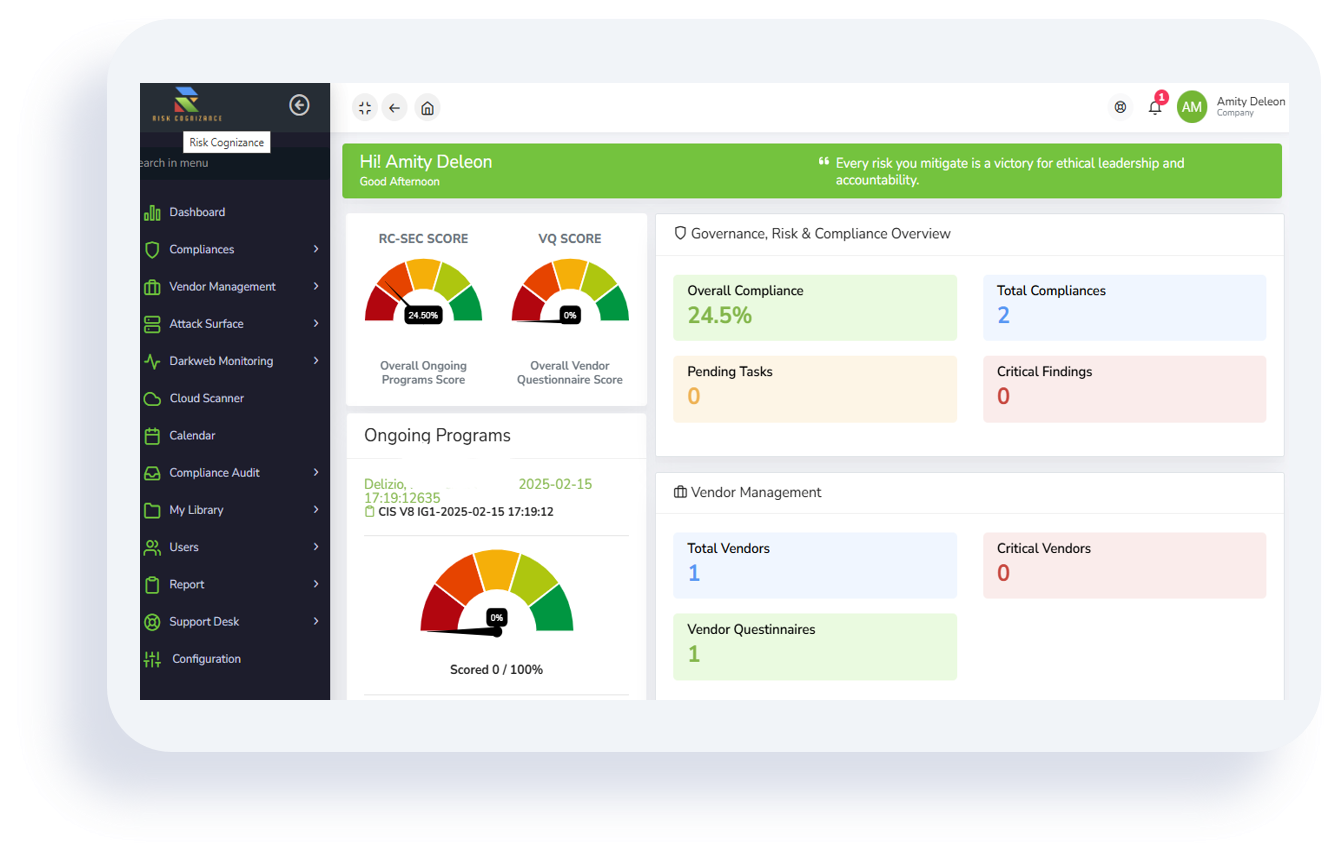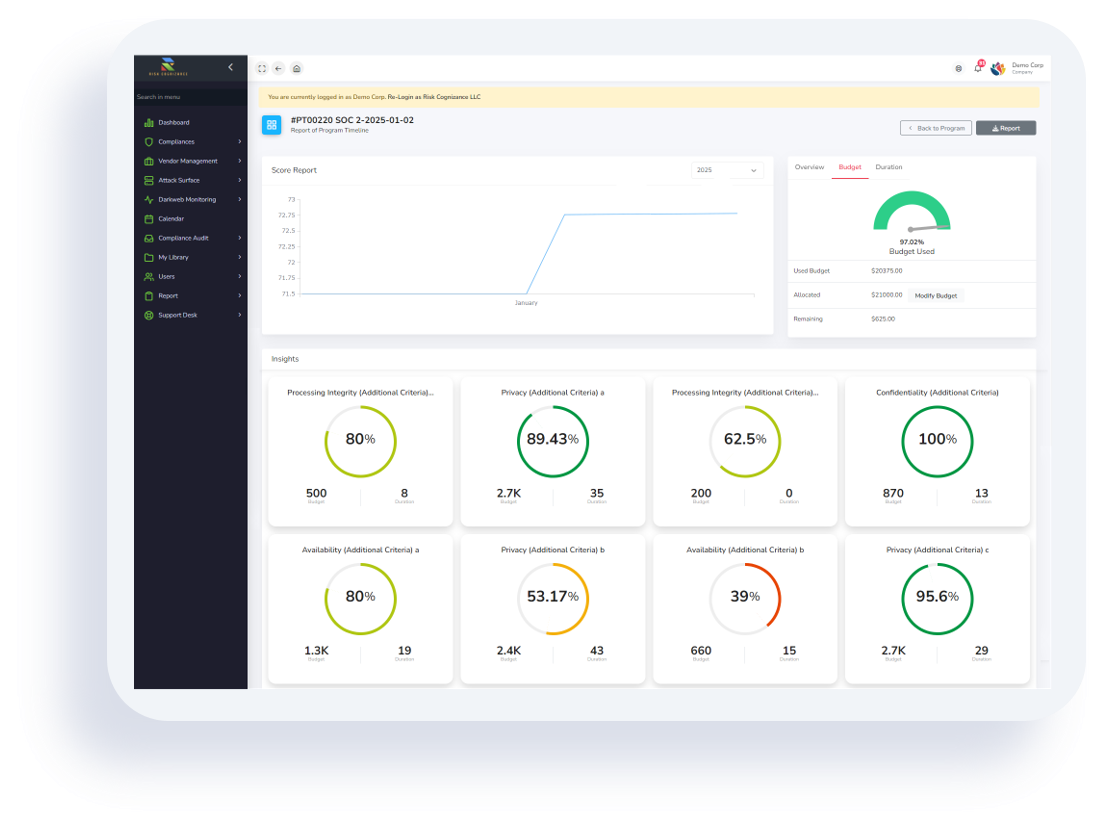
How to Choose a Compliance Management Tool
How to Choose a Compliance Management Tool
Regulatory and cybersecurity risks are evolving faster than ever. Organizations must adopt intelligent solutions to ensure compliance, reduce risk exposure, and maintain operational efficiency.
A Compliance Management Tool serves as the backbone of a robust risk and governance strategy automating complex processes, centralizing data, and ensuring adherence to frameworks like ISO 27001, GDPR, NIST, and other industry standards.
Understanding Compliance Management Tools
Compliance software helps organizations identify, track, and manage regulatory obligations across their operations. These platforms automate compliance workflows, reduce manual effort, and deliver real-time visibility into organizational risk. The right compliance management solution not only ensures adherence to standards but also strengthens cybersecurity posture and business resilience.
Risk Cognizance is a compliance automation platform that streamlines the process of obtaining and maintaining industry certifications. It helps organizations achieve continuous compliance through automation, policy alignment, and intelligent monitoring.
Key Features of a Modern Compliance Management Tool
When choosing a compliance management tool, look for these critical capabilities to ensure scalability, security, and effectiveness.
1. Risk Management
A powerful tool should help identify, assess, and mitigate risks to IT infrastructure. Risk Cognizance’s IT Risk Management software provides a unified approach to managing cybersecurity threats such as network vulnerabilities, software exploits, and data leaks—allowing organizations to strengthen cyber resilience with ease.
2. Compliance Management
Your chosen software must align with both global standards and industry-specific regulations. Risk Cognizance automates compliance across frameworks such as ISO 27001, NIST 800-53, and GDPR, helping organizations maintain real-time audit readiness and reduce compliance gaps.
3. Policy Management
Centralized policy management simplifies the creation, distribution, and enforcement of security policies. The Risk Cognizance platform ensures all users, systems, and processes operate under consistent and compliant governance structures.
4. Audit Management
A robust compliance solution should streamline audit workflows. Automated tracking, document control, and pre-audit assessments significantly reduce manual workloads. Risk Cognizance enables teams to respond to audits faster and more accurately—eliminating redundant processes.
5. Continuous Monitoring
Continuous monitoring ensures ongoing visibility into compliance and risk status. Risk Cognizance’s Continuous Controls Monitoring (CCM) feature provides automated checks, alerts, and real-time dashboards to help teams stay proactive rather than reactive.

Enterprise Cyber Risk & Security Platform
An effective compliance tool should not operate in isolation. IT cyber risk and compliance software connects governance, security, and operations into one holistic ecosystem. Platforms like Risk Cognizance GRC deliver enterprise-wide risk visibility by integrating threat detection, vulnerability management, and compliance intelligence.
Key functionalities of the Risk Cognizance Enterprise Cyber Risk & Security Platform include:
- Centralized risk assessments
- Continuous control monitoring
- Regulatory alignment with GDPR, NIST, and ISO
- Automated evidence collection
- Real-time executive reporting
Automated Governance, Risk & Compliance Software
Future-proof your compliance operations with Risk Cognizance’s Automated GRC Software. The platform streamlines governance, risk, and compliance management through automation and AI-driven analytics. It empowers organizations to measure, remediate, and communicate their cyber risk posture effectively.
With Risk Cognizance, organizations can:
- Automate risk and compliance workflows
- Simplify audit and reporting processes
- Maintain continuous compliance monitoring
- Enhance data-driven decision-making
Choosing the right Compliance Management Tool (often part of a broader Governance, Risk, and Compliance, or GRC, platform) is a critical decision that balances your immediate needs with your long-term scalability.
The selection process should be driven by a structured evaluation of your business requirements against the core capabilities of the software.
Here is a comprehensive guide on how to choose a compliance management tool:
Step 1: Define Your Compliance Scope & Goals
Before looking at any software, you must clearly define what you need the tool to accomplish.
Question | Why it Matters | Impact on Tool Selection |
|---|---|---|
What frameworks apply to you? | Your immediate goal (e.g., closing a deal that requires SOC 2 or ISO 27001) determines the tool's primary focus. | Choose a tool with native, well-supported modules for your top 1-3 frameworks (e.g., SOC 2, HIPAA, GDPR, PCI-DSS). |
What is your risk priority? | Are you focused purely on compliance checklists, or do you need a tool to manage broader Enterprise Risk Management (ERM) and risk scoring? | Compliance Automation Platforms (like Vanta/Drata) excel at compliance. Full GRC Platforms (like MetricStream, ServiceNow GRC) offer deeper risk management. |
What is your team size/maturity? | A small startup needs simplicity and speed. A large enterprise needs deep customization and complex workflows. | Startups/SMBs often prefer platforms with guided roadmaps and high automation. Enterprises need role-based access and multi-entity support. |
What is your budget? | Software fees, implementation costs, and auditor fees all impact the Total Cost of Ownership (TCO). | Cost is typically based on Employee Count + Number of Frameworks. Ensure the platform fee plus expected audit fee fits your budget. |
Step 2: Evaluate Essential Platform Capabilities (The 7 Pillars)
These are the non-negotiable features a modern compliance tool must possess.
Pillar | Must-Have Feature | Key Question to Ask Vendors |
|---|---|---|
1. Automation & Evidence | Continuous Monitoring: The tool must automatically collect evidence (screenshots, configurations, log data) from your tech stack 24/7. | "Show me how the platform automatically collects evidence for a failed control (e.g., missing 2FA) and what the alert looks like." |
2. Integration | Deep, Native Connections: Seamless integration with your cloud provider (AWS/Azure/GCP), HRIS (BambooHR/Gusto), Code Repositories (GitHub/GitLab), and identity provider (Okta/Azure AD). | "Can you demonstrate the two-way integration with our specific HRIS/IDP and show the data that is pulled?" |
3. Framework & Mapping | Cross-Mapping: The ability to use one piece of evidence (e.g., "all employees have 2FA enabled") to satisfy controls for multiple frameworks (SOC 2, ISO, HIPAA). | "If we implement SOC 2 and later add ISO 27001, how much new work will we have to do?" |
4. Risk Management | Centralized Risk Register: A module to track, assess, score, and prioritize custom risks that are then mapped to your security controls. | "How do we define a custom risk, assign it an owner, and link it to a specific control in the platform?" |
5. Audit Experience | Audit Hub/Readiness: A feature that allows your auditor to securely log in, review collected evidence, and mark controls as approved without leaving the platform. | "Walk me through a simulated auditor experience and how the tool reduces the time spent on the evidence-gathering phase of the audit." |
6. User Experience (UX) | Intuitive Interface: Clear dashboards, automated task assignment, and a simple interface that encourages adoption by non-security stakeholders (HR, Engineering). | "Is the policy library customizable? Can a non-technical employee easily complete their security training task and confirm policy review?" |
7. Scalability | Multi-Entity/Multi-Framework: The ability to add new business units, new countries, or new compliance frameworks without a complete system overhaul. | "If we acquire a new company or expand to an EU office, what is the process for onboarding that entity into our existing compliance program?" |
Step 3: Evaluate the Total Cost of Ownership (TCO)
Look beyond the annual subscription price, as GRC tools have many hidden costs.
Cost Component | What to Clarify | Impact on TCO |
|---|---|---|
Platform Fee | Is it based on Total Employees or Employees with System Access? What is the renewal rate? | Many platforms charge a higher fee if your headcount grows during the year. |
Framework Fees | Is the first framework included? How much is each additional framework (HIPAA, ISO, etc.)? | These are often sold as expensive add-ons. Negotiate a bundled price for future frameworks upfront. |
Add-on Fees | What is the cost for features like Vendor Risk Management (VRM), Security Questionnaires, or User Access Reviews (UAR)? | These are often not included in the base price and can easily add $5,000 – $15,000+ to the annual bill. |
Implementation/ Support | Are there one-time setup fees? Is premium/dedicated support included in the subscription? | Negotiate to have setup/onboarding fees waived or heavily discounted in the initial contract. |

Choosing the Right Compliance Tool for Your Organization
When evaluating compliance management tools, consider the following factors:
- Scalability: Can the platform grow with your organization’s needs?
- Integration: Does it integrate with your existing IT, risk, and audit systems?
- Automation: Does it reduce manual effort and human error?
- Visibility: Can you access real-time compliance and risk insights?
- Support: Does the vendor offer expert guidance for implementation and ongoing compliance?
Risk Cognizance provides all of these capabilities—and more through a single unified platform. Its AI-driven compliance automation delivers actionable insights that empower organizations to stay ahead of regulatory demands while improving operational resilience.
Conclusion
Choosing the right compliance management tool is crucial to maintaining trust, protecting data, and meeting regulatory obligations. The ideal solution should combine automation, analytics, and continuous monitoring to reduce complexity and improve efficiency.
With Risk Cognizance, organizations gain a powerful ally in achieving continuous compliance, mitigating cyber risks, and driving operational excellence.


